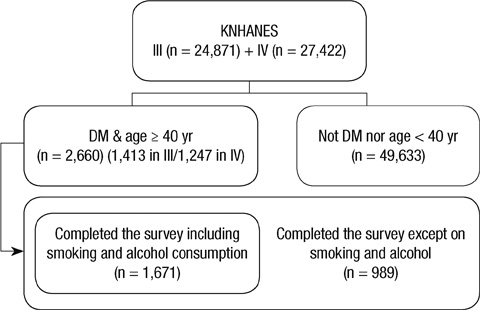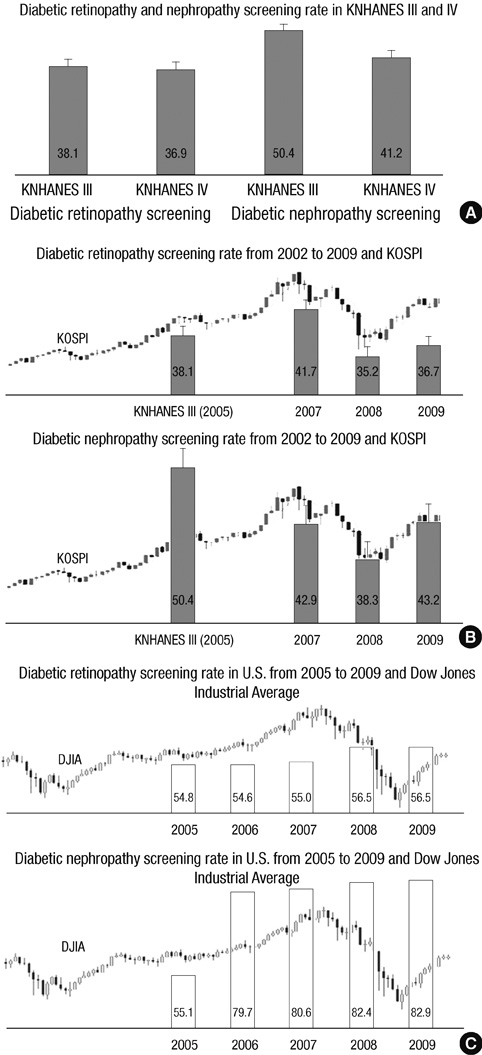J Korean Med Sci.
2013 Jun;28(6):814-820. 10.3346/jkms.2013.28.6.814.
Factors Associated with Diabetic Retinopathy and Nephropathy Screening in Korea: The Third and Fourth Korea National Health and Nutrition Examination Survey (KNHANES III and IV)
- Affiliations
-
- 1Institute of Vision Research, Department of Ophthalmology, Yonsei University College of Medicine, Seoul, Korea. yoonjs@yuhs.ac
- 2Department of Medicine, Yonsei University College of Medicine, Seoul, Korea.
- 3Department of Internal Medicine, Yonsei University College of Medicine, Seoul, Korea.
- KMID: 2158026
- DOI: http://doi.org/10.3346/jkms.2013.28.6.814
Abstract
- This cross-sectional study was done to identify and determine the socio-demographic and health-related factors associated with diabetic retinopathy and nephropathy screening in Korea. Participants included 2,660 adults, aged 40 or older, with diabetes. Of the 2,660 adults, 998 (37%) and 1,226 (46.1%) had received a diabetic retinopathy and a nephropathy screening within one year, respectively. Regarding retinopathy, subjects older than 65, living in urban areas, with high educational levels, and with self-reported "unhealthy" status were likely to receive annual screening. Subjects living in urban areas, with higher educational levels, with self-reported "fair" or "unhealthy" status, and with 1 to 2 co-morbidities were likely to receive annual nephropathy screening. The Korea Composite Stock Price Index (KOSPI) continued to rise until 2007 when it started to decline over the subsequent years, following the same curve as the diabetic retinopathy and nephropathy screening rates during that time. Together with the financial matter, lack of patient education proved to be a hindrance to diabetes-related screening. The relatively low screening rates in Korea compared to the Western countries are likely to be due to the difference in the health system, economic situations and national demographics.
Keyword
MeSH Terms
-
Adult
Aged
Cross-Sectional Studies
Diabetes Complications/pathology
Diabetes Mellitus/diagnosis
Diabetic Nephropathies/diagnosis/*etiology
Diabetic Retinopathy/diagnosis/*etiology
Female
Health Behavior
Health Status
Humans
Male
Mass Screening
Middle Aged
Nutrition Surveys
Odds Ratio
Republic of Korea
Risk Factors
Severity of Illness Index
Figure
Cited by 1 articles
-
Current Status and Future Expectations of Cataract Surgery in Korea: KNHANES IV
Tyler Hyung Taek Rim, Young Jae Woo, Hyun Joo Park, Sung Soo Kim,
J Korean Ophthalmol Soc. 2014;55(12):1772-1778. doi: 10.3341/jkos.2014.55.12.1772.
Reference
-
1. Congdon NG, Friedman DS, Lietman T. Important causes of visual impairment in the world today. JAMA. 2003. 290:2057–2060.2. Varma R. From a population to patients: the Wisconsin epidemiologic study of diabetic retinopathy. Ophthalmology. 2008. 115:1857–1858.3. Photocoagulation for diabetic macular edema: Early Treatment Diabetic Retinopathy Study report number 1: Early Treatment Diabetic Retinopathy Study research group. Arch Ophthalmol. 1985. 103:1796–1806.4. Javitt JC, Aiello LP, Chiang Y, Ferris FL 3rd, Canner JK, Greenfield S. Preventive eye care in people with diabetes is cost-saving to the federal government: implications for health-care reform. Diabetes Care. 1994. 17:909–917.5. Javitt JC, Canner JK, Frank RG, Steinwachs DM, Sommer A. Detecting and treating retinopathy in patients with type I diabetes mellitus: a health policy model. Ophthalmology. 1990. 97:483–494.6. Talley NJ, O'Connor S. Examination medicine: a guide to physician training. 2010. 6th ed. Sydney: Churchill Livingston, Elsevier.7. Braveman P. Health disparities and health equity: concepts and measurement. Annu Rev Public Health. 2006. 27:167–194.8. Deaton A, Lubotsky D. Mortality, inequality and race in American cities and states. Soc Sci Med. 2003. 56:1139–1153.9. Defining an international standard for overweight and obesity in childhood. BMJ. 2000. 320:0.10. Centers for Disease Control and Prevention (CDC). Cigarette smoking among adults: United States, 1992, and changes in the definition of current cigarette smoking. MMWR Morb Mortal Wkly Rep. 1994. 43:342–346.11. World Health Organization, Department of Mental Health Substance Dependence, Noncommunicable Diseases Mental Health Cluster. International guide for monitoring alcohol consumption and related harm. 2000. Geneva: World Health Organization.12. Ainsworth BE, Haskell WL, Whitt MC, Irwin ML, Swartz AM, Strath SJ, O'Brien WL, Bassett DR Jr, Schmitz KH, Emplaincourt PO, et al. Compendium of physical activities: an update of activity codes and MET intensities. Med Sci Sports Exerc. 2000. 32:S498–S504.13. Yudkin JS, Boucher BJ, Schopflin KE, Harris BT, Claff HR, Whyte NJ, Taylor B, Mellins DH, Wootliff AB, Safir JG, et al. The quality of diabetic care in a London health district. J Epidemiol Community Health. 1980. 34:277–280.14. Hartnett ME, Key IJ, Loyacano NM, Horswell RL, Desalvo KB. Perceived barriers to diabetic eye care: qualitative study of patients and physicians. Arch Ophthalmol. 2005. 123:387–391.15. Brechner RJ, Cowie CC, Howie LJ, Herman WH, Will JC, Harris MI. Ophthalmic examination among adults with diagnosed diabetes mellitus. JAMA. 1993. 270:1714–1718.16. Saaddine JB, Engelgau MM, Beckles GL, Gregg EW, Thompson TJ, Narayan KM. A diabetes report card for the United States: quality of care in the 1990s. Ann Intern Med. 2002. 136:565–574.17. Mukamel DB, Bresnick GH, Wang Q, Dickey CF. Barriers to compliance with screening guidelines for diabetic retinopathy. Ophthalmic Epidemiol. 1999. 6:61–72.18. Aoki N, Dunn K, Fukui T, Beck JR, Schull WJ, Li HK. Cost-effectiveness analysis of telemedicine to evaluate diabetic retinopathy in a prison population. Diabetes Care. 2004. 27:1095–1101.19. Whited JD, Datta SK, Aiello LM, Aiello LP, Cavallerano JD, Conlin PR, Horton MB, Vigersky RA, Poropatich RK, Challa P, et al. A modeled economic analysis of a digital tele-ophthalmology system as used by three federal health care agencies for detecting proliferative diabetic retinopathy. Telemed J E Health. 2005. 11:641–651.20. Legorreta AP, Hasan MM, Peters AL, Pelletier KR, Leung KM. An intervention for enhancing compliance with screening recommendations for diabetic retinopathy: a bicoastal experience. Diabetes Care. 1997. 20:520–523.21. Parry J, Humphreys G. Health amid a financial crisis: a complex diagnosis. Bull World Health Organ. 2009. 87:4–5.22. Neumayer E. Recessions lower (some) mortality rates: evidence from Germany. Soc Sci Med. 2004. 58:1037–1047.23. Lusard A, Schneider DJ, Tufano P. The economic crisis and medical care usage: NBER Working Paper. No. 15843. 2010. Cambridge: National Bureau of Economic Research;1–24.24. Yang BM, Prescott N, Bae EY. The impact of economic crisis on healthcare consumption in Korea. Health Policy Plan. 2001. 16:372–385.
- Full Text Links
- Actions
-
Cited
- CITED
-
- Close
- Share
- Similar articles
-
- Factors Associated with Screening for Diabetic Retinopathy in Diabetic Patients Aged > or = 40 Years Using the KNHANES IV
- Hormone Replacement Therapy and Eye Diseases: KNHANES IV
- Trends and Barriers in Diabetic Retinopathy Screening: Korea National Health and Nutritional Examination Survey 2016–2021
- Risk Factor Analysis of Diabetic Retinopathy Diagnosed with Non-mydriatic Fundus Camera: KNHANES V
- The Korea National Health and Nutrition Examination Survey data linked Cause of Death data



